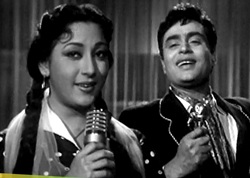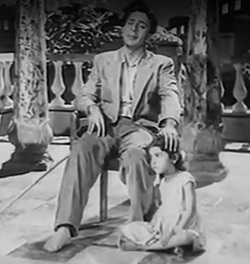Dec 13, 2025
Dec 13, 2025
The latter half of the 1950s – Part 5
Vyjayantimala
Vyjayantimala established herself as an effective emotional actress, apart from a dancing star who could perform Bharatanatyam, Kathak, Bhangra, and Western dances with equal ease. In this period, she acted in as many as 21 Hindi films, opposite all the top stars in Hindi films and under the top directors of the time. In Vijay Bhatt's Patrani, Vyjayantimala starred opposite Pradeep Kumar. Based on a true story, it is about a king who falls in love with a princess after seeing her portrait and marries her in the traditional Rajput style of sending his sword as a proxy. But he rejects her when he sees her and finds that she is dark-hued. Despite a good theme and some good music by Shankar Jaikishan, the film did not do well. Lata Mangeshkar's solos, Chandrama madbhara kyon jhoome badar me, kabhi to aa kabhi to aa, and chorus song arre koi jao re are worth listening to. In Amardeep, a remake of a Tamil movie with the same title, Vyjayantimala was cast opposite Dev Anand, with a music score by C Ramchandra. It was based on the Bengali movie Harano Sur (1957), an adaptation of the 1942 American film Random Harvest. Some of the memorable songs are the Lata Mangeshkar duet with Mohammed Rafi, dekh hamen awaz na dena o bedardzamane and Lata’s solos, Dil ki duniya basa ke sanwariya and Mere man ka banwra panchhi.
Amiya Chakraborty’s Kathputli was his last film. It is the story of a dancer, a puppeteer, and a wealthy man, played by Balraj Sahni, who helps the dancer when the puppeteer is crippled in an accident. It has some beautiful dances including one by Bharatanatyam dancer Kamala Lakshman. Shankar Jaikishan composed some hit songs, including Lata Mangeshkar solos, Bol ri kathputli and Haye tu hi gaya mohe bhool re and a duet, Manzil wohi hai pyar ki by Lata Mangeshkar and Subir Sen. In Satyen Bose’s Sitaron se aage, Vyjayantimala acted opposite Ashok Kumar for the first time.
 The story of BR Chopra’s Sadhna, penned by Mukhram Sharma is about a prostitute, who finds love unexpectedly and then struggles to fulfill it. Sahir Ludhiyanvi’s lyrics, pregnant with meaning, were< moving. Tuned by music director N Datta, Lata Mangeshkar’s solos, Aurat ne janam diya mardon ko, and kahoji tum kya kya kharidoge, chorus qawwali led by Mohammed Rafi, Aaj kyun humse pardah hai and Geeta Dutt’s bhajan Tora manva kyun ghabaraye re are long-lasting hits. Vyjayantimala won the Filmfare Award for Best Actress for her performance.
The story of BR Chopra’s Sadhna, penned by Mukhram Sharma is about a prostitute, who finds love unexpectedly and then struggles to fulfill it. Sahir Ludhiyanvi’s lyrics, pregnant with meaning, were< moving. Tuned by music director N Datta, Lata Mangeshkar’s solos, Aurat ne janam diya mardon ko, and kahoji tum kya kya kharidoge, chorus qawwali led by Mohammed Rafi, Aaj kyun humse pardah hai and Geeta Dutt’s bhajan Tora manva kyun ghabaraye re are long-lasting hits. Vyjayantimala won the Filmfare Award for Best Actress for her performance.
SS Vasan’s Paigham, starring the same leading pair as in Madhumati, along with Motilal, Raj Kumar, and B Saroja Devi, was a social drama involving two brothers who find themselves on opposite sides in an industrial dispute. Yahi paigham hamara, sung by Manna Dey, and chorus, tuned by C Ramchandra, became popular. in the 6th Filmfare Awards in 1959, Raj Kumar was nominated for Best Supporting Actor. Dilip Kumar had dual nominations for Best Actor in Madhumati and Paigham, but the Award went to Dev Anand for Kala Pani.
Shammi Kapoor
 In 1953, film director Lekhraj Bhakri spotted a schoolgirl called Qamar Sultana in Mumbai, regaling her friends by enacting roles played by Madhubala, adopting her mannerisms, with dialogues and songs. He cast her in his film Thokar (1953) giving her the screen name Jayjaywanti. In the same year, she made her debut in a leading role in Vijay Bhatt’s Shri Chaitanya Mahaprabhu, with a new name, Ameeta. The film failed to make an impact, although Bharat Bhushan in the title role won the Filmfare Award for Best Actor in 1955. Side roles followed in Filmistan’s Munimji, Aab-e-hayat, and Hum Sab Chor Hain, Aspi Irani’s Shirin Farhad and Amiya Chakraborty’s Dekh Kabira Roya, until she attracted the attention of Tolaram Jalan, co-owner of Filmistan Studios. He decided to launch her as the heroine of his next film opposite Dev Anand. As Tolaram Jalan’s protégée Ameeta, was given special treatment with her make-up, wardrobe, and lighting. Much of the film's extensive publicity was also built around the actress. Nasir Hussain, writer of Filmistan’s megahit movies Munimji and Paying Guest was entrusted with directing the film. When Dev Anand declined to act in the film it was offered to the then-struggling Shammi Kapoor.
In 1953, film director Lekhraj Bhakri spotted a schoolgirl called Qamar Sultana in Mumbai, regaling her friends by enacting roles played by Madhubala, adopting her mannerisms, with dialogues and songs. He cast her in his film Thokar (1953) giving her the screen name Jayjaywanti. In the same year, she made her debut in a leading role in Vijay Bhatt’s Shri Chaitanya Mahaprabhu, with a new name, Ameeta. The film failed to make an impact, although Bharat Bhushan in the title role won the Filmfare Award for Best Actor in 1955. Side roles followed in Filmistan’s Munimji, Aab-e-hayat, and Hum Sab Chor Hain, Aspi Irani’s Shirin Farhad and Amiya Chakraborty’s Dekh Kabira Roya, until she attracted the attention of Tolaram Jalan, co-owner of Filmistan Studios. He decided to launch her as the heroine of his next film opposite Dev Anand. As Tolaram Jalan’s protégée Ameeta, was given special treatment with her make-up, wardrobe, and lighting. Much of the film's extensive publicity was also built around the actress. Nasir Hussain, writer of Filmistan’s megahit movies Munimji and Paying Guest was entrusted with directing the film. When Dev Anand declined to act in the film it was offered to the then-struggling Shammi Kapoor.
Shammi Kapoor shed his image of a soft romantic lover and developed a new look with a youthful style, a serenading, prancing hero. The film's huge success made Shammi Kapoor an overnight sensation, overshadowing the heroine who was to be launched. OP Nayyar’s music was an essential element in the success of the film. Sahir Ludhianvi wrote the title song Tumsa nahin dekha, and Majrooh Sultanpuri wrote the rest. Tumsa nahin dekha, Jawaniyan ye mast mast and Chhupne wale saamne aa were major hits but the bhangra number, sar par topi lal topped them all in popularity and firmly established the place of bhangra songs and dances in Hindi films.
The credit for introducing Bhangra, the ethnic sound from the soil of Punjab, into Hindi films goes to Salil Chowdhary, the Bengali music director who was steeped in Indian folk music. Viewers saw the dance and tapped for its music for the first time in Teki main jhuth boliya from Jagte Raho (1956). Bara barsi khatan gaya si from New Delhi (1956), Ude jab jab zulfen teri from Naya Daur (1957) followed. The success of Sar par topi lal impelled producers to include a bhangra item in every film thereafter.
In 1958 Sasadhar Mukherjee left Filmistan to form his own production company called Filmalaya Studios. His first production, directed by Nasir Hussain was Dil Deke Dekho. Asha Parekh, who had started acting as a child in Bimal Roy’s Maa (1952), was cast as the heroine opposite Shammi Kapoor, fresh from his success in Tumsa Nahin Dekha. Sasadhar Mukherjee entrusted the music direction to a young woman composer called Usha Khanna, who was introduced to him by OP Nayyar. A light-hearted comedy, Dil Deke Dekho was the fifth highest-grossing films in 1959 and its songs were hits, particularly, Dil deke dekho Hum aur tum aur ye sama, and Bolo bolo kuchh to bolo sung by Mohammed Rafi for Shammi Kapoor and Rafi and Asha Bhonsle’s duet Bade hain dil ke kale.
FC Mehra’s Ujala, directed by Naresh Saigal starred Shammi Kapoor opposite Mala Sinha with Raj Kumar in an important role. A story of the conflict between honesty and crime, the film was moderately successful with the aid of some wonderful tunes composed by Shankar Jaikishan. Manna Dey & Lata Mangeshkar duets Jhoomta Mausam masta mahina, and Chham Chham Lo Suno Chham, Mukesh & Lata duet Duniya walon se door, Lata Mangeshkar solos Tera jalwa jisne dekha, , O mere nadan balama, and Manna Dey solo Ab Kahan jayen hum were all hits.
The Mother India Trio
The new generation of actors who got a boost in Mehboob Khan’s Mother India, began to assert themselves. The most successful of the three was Rajendra Kumar. After Mother India, he starred in Mahesh Kaul’s Talaq (1958), based on a story by Mukhram Sharma, which was well-received by critics. C Ramchandra composed one of his best songs Mere Jeevan Mein Kiran Ban Ke, written by Pradeep and sung by Manna Dey and Asha Bhonsle.
In 1959, Rajendra Kumar got three back-to-back hits, Vijay Bhatt's romantic musical Goonj Uthi Shehnai, opposite Ameeta, Devendra Goel’s tear-jerker Chirag Kahan Roshni Kahan, opposite Meena Kumari and Yash Chopra's romantic social drama Dhool Ka Phool, opposite Mala Sinha and Nanda. This was the beginning of a series of jubilee hits that earned him the epithet ‘Jubilee Kumar’
Vijay Bhatt’s Goonj Uthi Shehnai is about an aspiring Shehnai player, his childhood sweetheart, and his struggle for recognition. Shehnai maestro Ustad Bismillah Khan played the shehnai and Sitar player, Abdul Halim Jaffar Khan was featured in a jugalbandi sequence. Sensitive performances by the leading pair, and soul-stirring music contributed to the film’s success. It was the first big hit of actor Rajendra Kumar. Music director Vasant Desai, teamed up with lyricist Bharat Vyas to create hits such as Jivan men piya tera sath rahe, sung by Lata Mangeshkar and Mohammed Rafi, and Lata's Tere sur aur mere geet, and Dil ka khilona haye toot gaya, and Mohammed Rafi’s soulful Kehdo koyi na kare yahan pyar.
 Yash Chopra made his debut as a director with Dhool Ka Phool, the beginning of a long and distinguished career. The theme of the travails of an unwed mother was bold for its time. Sensitive lyrics, written by Sahir Ludhianvi, and tuned by music director N Datta, were very popular. Lata Mangeshkar’s Tu mere pyar ka phool hai, Lata Mangeshkar and Mahendra Kapoor duets, Tere pyar ka aasra chahta hoon and Dhadakne lagi dil ke taron ki duniya, and Mohammed Rafi’s Tu hindu banega na musalman banega, are everlasting songs. Chirag Kahan Roshni Kahan was about a child separated from his parents told in a melodramatic style, designed to pull the heartstrings of its viewers. The title song tuned by Ravi and sung by Mohammed Rafi was popular.
Yash Chopra made his debut as a director with Dhool Ka Phool, the beginning of a long and distinguished career. The theme of the travails of an unwed mother was bold for its time. Sensitive lyrics, written by Sahir Ludhianvi, and tuned by music director N Datta, were very popular. Lata Mangeshkar’s Tu mere pyar ka phool hai, Lata Mangeshkar and Mahendra Kapoor duets, Tere pyar ka aasra chahta hoon and Dhadakne lagi dil ke taron ki duniya, and Mohammed Rafi’s Tu hindu banega na musalman banega, are everlasting songs. Chirag Kahan Roshni Kahan was about a child separated from his parents told in a melodramatic style, designed to pull the heartstrings of its viewers. The title song tuned by Ravi and sung by Mohammed Rafi was popular.
Sunil Dutt starred in several successful films including Sadhna, Post Box 999, Sujata, Insan Jag Utha, and Didi. Ravindra Dave’s Post Box 999, a crime thriller, saw the entry of a new music director. Kalyanji Virji Shah, who had played the clavioline in Nagin for the theme music, became a music director with this film. After providing music for a few films on his own, he combined with his brother Anand and the duo of Kalyanji-Anandji had a long and distinguished career. Hemant Kumar, Lata Mangeshkar duet O neend na mujhko aaye and Lata Mangeshkar’s Ara rara rara main to girire girire girire were popular.
Didi was produced by Marathi film producer Sadashiv J.Row Kavi and directed by K.Narayan Kale. Didi is remembered for the song, Tum mujhe bhul bhi jao to yeh haq hai tum ko, sung by Sudha Malhotra and Mukesh. N Dutta was the music director, and the lyrics were written by Sahir Ludhianvi. When N Dutta fell sick, Sahir Ludhianvi pursuaded Sudha Malhotra to step in to compose the tune for the song.
Raaj Kumar, the third emerging star in Mother India, did not enjoy the same degree of success as the other two. He played the lead in three films of which only Nausherwan-e-Adil was successful but in Paigham, Shararat, and Ujala, in which played the second lead, he made his presence felt.
Balraj Sahni
 Balraj Sahni was his usual effective self in all the films in which he was featured, especially in Pardesi, Kathputli, Bhabhi, Lajwanti, and Chhoti Bahen. Satta Bazaar focused on the perils of betting in the stock market. The new duo Kalyanji-Anandji provided music with Chaandi Ke Chand Tukadon Ke Liye, sung by Hemant Kumar and Tumhe Yaad Hoga, a duet by Hemant Kumar and Lata Mangeshkar being popular. Another endearing performance came from Balraj Sahni in Heera Moti, based on Munshi Premchand’s story. One of my favorite songs is the duet Kaun rang munguwa, composed by Roshan and sung by Suman Kalyanpur and Sudha Malhotra.
Balraj Sahni was his usual effective self in all the films in which he was featured, especially in Pardesi, Kathputli, Bhabhi, Lajwanti, and Chhoti Bahen. Satta Bazaar focused on the perils of betting in the stock market. The new duo Kalyanji-Anandji provided music with Chaandi Ke Chand Tukadon Ke Liye, sung by Hemant Kumar and Tumhe Yaad Hoga, a duet by Hemant Kumar and Lata Mangeshkar being popular. Another endearing performance came from Balraj Sahni in Heera Moti, based on Munshi Premchand’s story. One of my favorite songs is the duet Kaun rang munguwa, composed by Roshan and sung by Suman Kalyanpur and Sudha Malhotra.
Talat Mehmood
Talat Mehmood continued his vain quest for glory as an actor in four movies with the leading actresses of the day, Ek gaon ki kahani opposite Mala Sinha, Lala Rukh opposite Shyama, Maalik opposite Suraiya and Sone ki Chidiya opposite Nutan. Each time, it became obvious that his multitude of admirers preferred him as a singer. Talat Mehmood’s songs, Raat ne kya kya khwab dikhaye from Ek gaon ki kahani, tuned by Salil Chowdhary, Pyas kuchh aur bhi bhadka di, from Lala Rukh, tuned by Khayyam, and Pyar par bas to nahin hai, from Sone ki Chidiya, tuned by OP Nayyar, are still popular. So is Talat’s duet with Suraiya, Man dheere dheere gaaye re, from Malik, tuned by Ghulam Mohammed. Other long-lasting songs are, Mohammed Rafi’s Hai kali kali ke lab par from Lala Rukh and Raat bhar ka hai mehman andhera, a duet sung by Mohammed Rafi and Asha Bhonsle from Sone ki Chidiya.
14-Dec-2024
More by : Ramarao Annavarapu

|
'Tum sa Nahi Dekha' was the first major Hindi film that inspired me to develop interest in Hindi films and songs.I was in 3rd form then. Earlier films like 'Mela'could not impress me much, as I was too young. Reading your recollections helps one revisit the past passionately and relive those happy moments. Best regards sir. |

|
Delightful. |

|
Vyjayantimala, Shammi Kappor, Sunil Dutt, Mala Sinha, Talat Mehmood, Dev Anand... these were the timeless heroes of an age thats now slipped into history. The songs, the acting, the plots, and the monochrome image... all point to a golden age we all long to relive, an age which is impossible to replicate today. But we may take hope. We may yet ponder over the past, we may watch these timeless classics, and rejoice. Nothing can quite equal the charm of watching a classic movie. Cheers ! |